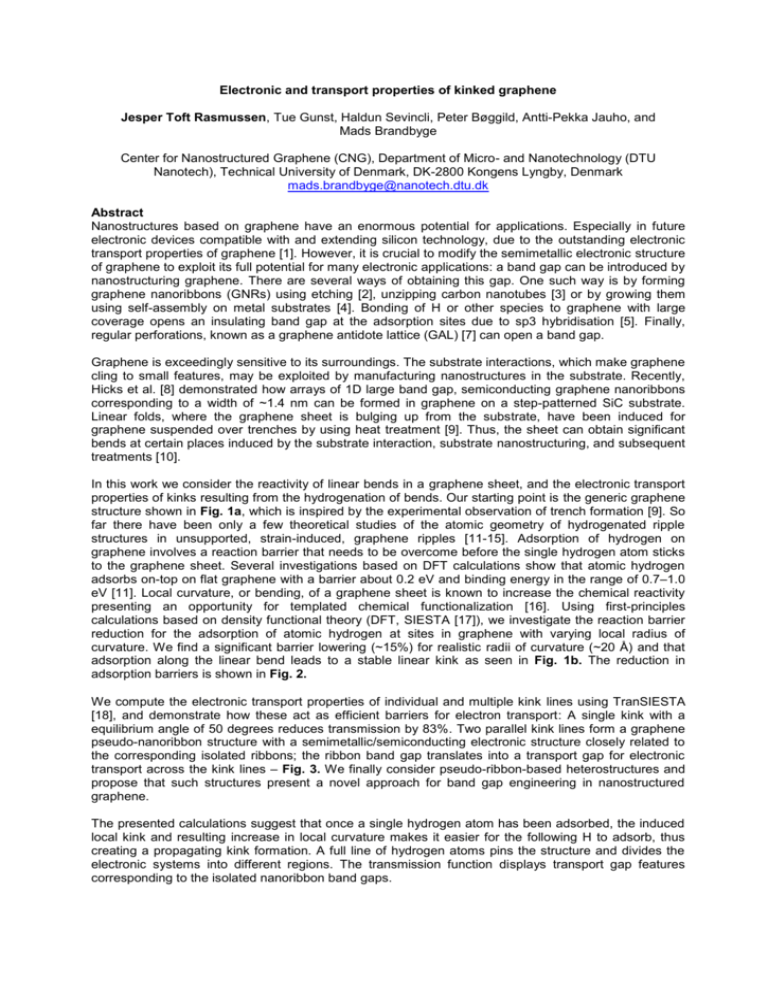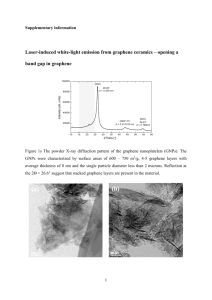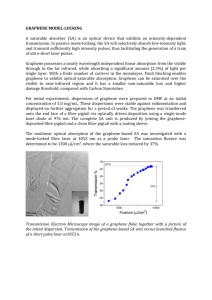Spin polarized transport in semiconductors – Challenges for
advertisement

Electronic and transport properties of kinked graphene Jesper Toft Rasmussen, Tue Gunst, Haldun Sevincli, Peter Bøggild, Antti-Pekka Jauho, and Mads Brandbyge Center for Nanostructured Graphene (CNG), Department of Micro- and Nanotechnology (DTU Nanotech), Technical University of Denmark, DK-2800 Kongens Lyngby, Denmark mads.brandbyge@nanotech.dtu.dk Abstract Nanostructures based on graphene have an enormous potential for applications. Especially in future electronic devices compatible with and extending silicon technology, due to the outstanding electronic transport properties of graphene [1]. However, it is crucial to modify the semimetallic electronic structure of graphene to exploit its full potential for many electronic applications: a band gap can be introduced by nanostructuring graphene. There are several ways of obtaining this gap. One such way is by forming graphene nanoribbons (GNRs) using etching [2], unzipping carbon nanotubes [3] or by growing them using self-assembly on metal substrates [4]. Bonding of H or other species to graphene with large coverage opens an insulating band gap at the adsorption sites due to sp3 hybridisation [5]. Finally, regular perforations, known as a graphene antidote lattice (GAL) [7] can open a band gap. Graphene is exceedingly sensitive to its surroundings. The substrate interactions, which make graphene cling to small features, may be exploited by manufacturing nanostructures in the substrate. Recently, Hicks et al. [8] demonstrated how arrays of 1D large band gap, semiconducting graphene nanoribbons corresponding to a width of ~1.4 nm can be formed in graphene on a step-patterned SiC substrate. Linear folds, where the graphene sheet is bulging up from the substrate, have been induced for graphene suspended over trenches by using heat treatment [9]. Thus, the sheet can obtain significant bends at certain places induced by the substrate interaction, substrate nanostructuring, and subsequent treatments [10]. In this work we consider the reactivity of linear bends in a graphene sheet, and the electronic transport properties of kinks resulting from the hydrogenation of bends. Our starting point is the generic graphene structure shown in Fig. 1a, which is inspired by the experimental observation of trench formation [9]. So far there have been only a few theoretical studies of the atomic geometry of hydrogenated ripple structures in unsupported, strain-induced, graphene ripples [11-15]. Adsorption of hydrogen on graphene involves a reaction barrier that needs to be overcome before the single hydrogen atom sticks to the graphene sheet. Several investigations based on DFT calculations show that atomic hydrogen adsorbs on-top on flat graphene with a barrier about 0.2 eV and binding energy in the range of 0.7–1.0 eV [11]. Local curvature, or bending, of a graphene sheet is known to increase the chemical reactivity presenting an opportunity for templated chemical functionalization [16]. Using first-principles calculations based on density functional theory (DFT, SIESTA [17]), we investigate the reaction barrier reduction for the adsorption of atomic hydrogen at sites in graphene with varying local radius of curvature. We find a significant barrier lowering (~15%) for realistic radii of curvature (~20 Å) and that adsorption along the linear bend leads to a stable linear kink as seen in Fig. 1b. The reduction in adsorption barriers is shown in Fig. 2. We compute the electronic transport properties of individual and multiple kink lines using TranSIESTA [18], and demonstrate how these act as efficient barriers for electron transport: A single kink with a equilibrium angle of 50 degrees reduces transmission by 83%. Two parallel kink lines form a graphene pseudo-nanoribbon structure with a semimetallic/semiconducting electronic structure closely related to the corresponding isolated ribbons; the ribbon band gap translates into a transport gap for electronic transport across the kink lines – Fig. 3. We finally consider pseudo-ribbon-based heterostructures and propose that such structures present a novel approach for band gap engineering in nanostructured graphene. The presented calculations suggest that once a single hydrogen atom has been adsorbed, the induced local kink and resulting increase in local curvature makes it easier for the following H to adsorb, thus creating a propagating kink formation. A full line of hydrogen atoms pins the structure and divides the electronic systems into different regions. The transmission function displays transport gap features corresponding to the isolated nanoribbon band gaps. References 1. Novoselov et al., Nature, 490 (2012) 192-200. 2. Han et al., Phys.Rev.Lett., 98 (2007), 206805. 3. Xie et al., J.Am.Chem.Soc., 133 (2011), 10394-10397. 4. Cai et al., Nature, 466 (2010), 470-473. 5. Elias et al., Science, 323 (2009), 610-613. 6. Balog et al., Nat.Mater., 9 (2010), 315-319. 7. Pedersen et al., Phys.Rev.Lett., 100 (2008), 136804. 8. Hicks et al., Nat. Phys., 9 (2013), 49–54 9. Bao et al., Nat. Nanotechnol., 4 (2009), 562– 566 10. Neek-Amal and Peeters, Phys. Rev. B, 85 (2012), 195445 11. Hornekær et al., Phys. Rev. Lett., 97 (2006), 186102 12. Srivastava et al., J. Phys. Chem. B, 103 (1999), 4330–4337 13. Wang et al., Phys. Rev. B, 83 (2011), 041403. 14. Chernozatonskii and Sorokin, J. Phys. Chem. C, 114 (2010), 3225–3229. 15. Chernozatonskii et al., Appl. Phys. Lett., 91 (2007), 183103 16. Ruffieux et al., Phys.Rev.B, 66 (2002) 245416. 17. Soler et al., J. Phys.: Condens. Matter, 14 (2002), 2745–2779 18. Brandbyge et al., Phys. Rev. B, 65 (2002), 165401 Figures Figure 1: (a) Smooth ripple-like structure where the first and last six rows of carbon-dimers are surface-clamped regions with a separation of L = 90 Å. Atomic hydrogen is adsorbed at positions I– VIII. (b) The resulting kinked graphene structure after hydrogen is adsorbed in lines at the most reactive position (II) corresponding to the smallest local radius of curvature. The four kinks divide the structure into five sections, S1–S5. Figure 2: Calculated reaction barriers for hydrogenation of bent graphene as a function of the local radius of curvature (II–VIII in Figure 1a). Flat graphene (position I) has an infinite radius of curvature and is used to normalise the barriers. calculations are spinpolarised and allow for atomic relaxation. Figure 3: (Left) Band structures for H-passivated armchair ribbons with varying width, N. (Right) The electronic transmission functions for the corresponding pseudo-ribbons.






